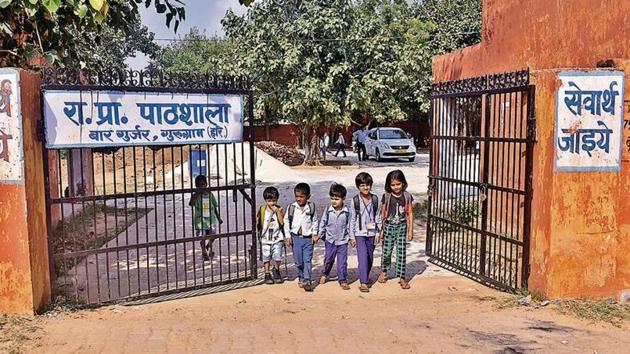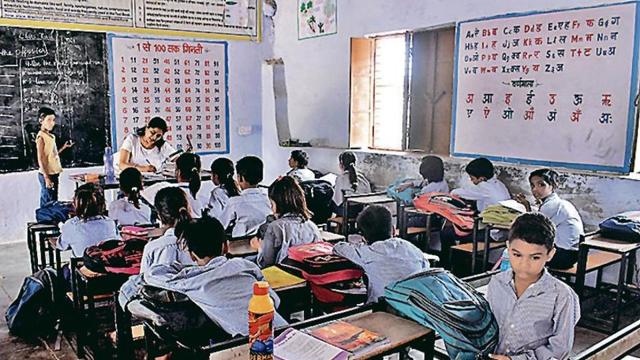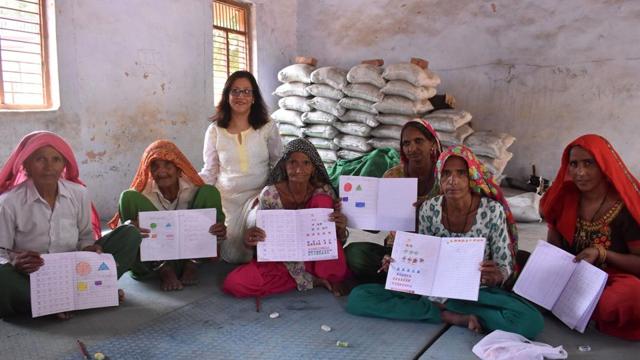Running a school against the odds in Gurugram’s Bar Gujjar
A closure notice to Government Primary School in Bar Gujjar of Gurugram district this April prompted two of its residents to collect funds, rope in volunteer teachers and increase the student count to keep the school running smoothly.
Eight-year-old Aditi sits in the first row, with a big smile and a well-oiled ponytail, in a classroom with colourful walls. Her smile, she says, reflects her good performance in the recently concluded English exam at the government primary school. Her neighbour and a couple of other students sit with a furrowed face, as they remained unsure of the answers for the fill-in-the-blanks grammar test.

This 50-year-old school government school, at Bar Gujjar, located near New Manesar Police Lines in Gurugram district, comes across as any other functional school in an Indian village, albeit in the backdrop of a withering extension of the Aravallis. But its buildings hide the struggles that two villagers face to keep the school running.
In April, the school, which has up to Class 5, had received a closure notice, citing lack of students, as it had only 25 registered students against the minimum requirement of 50. However, it has turned around its fate by the active participation of eager villagers and help from a condominium in the city.
In the last three months, the school has seen an increase in its student count from 32 to 57, installation of CCTV cameras, the addition of a water purifier, an inverter, a ceiling fan and 16 volunteer teachers.
Not wanting to wait for government funds, money for these improvements was pooled in by the villagers themselves. The faces behind this change are two 25-year-olds from the village — Sunil and Rahul. Sunil, previously a driver, quit his job six months ago to turn the school around. Joining him was Rahul, a farmer and among the 10-12 graduates in the village.
“I want one of these children to become an IPS officer one day. When I told them this, they did not know the meaning of it, but I am not stopping till it can be done,” said Rahul.

Sunil, a Class 10 graduate, set out to bring in more students to keep the school running. On a chance encounter, while being a part-time driver, he came across a resident of DLF New Town Heights in Sector 90 around four months ago. He said that he was driving her and a friend to Kasauli, and it turned into a discussion to save the school. Soon, Sunil had convinced the commuter, Priyanka Gambhir, to help restore the school.
She then started putting together a group willing to volunteer to teach at the school and at present, has a 20-strong batch of volunteers, who teach at the school for three hours, three days a week, in two batches. It mostly consists of former army personnel, retired teachers and homemakers. They are ferried back and forth from the condominium in a common car, charges for which are borne by the village.
“We have a morning shift and an afternoon shift. There is a roster and backups are also in place, in case someone is not able to make it,” said Gambhir.
For Virendra Kumar Sharma, a retired officer of the Indian Ordnance Factory Service, the past three months as a volunteer at the school has meant reaching the school by 8am. The time, he said, had been adjusted with his usual schedule for playing table tennis. “The enjoyment, however, is just the same, if not more,” he said.
Sunil said that the main reason parents gave for not sending their children to this school was lack of teachers. As there were only two teachers, all the students were clubbed together in one room, with no fan. “Once we got the renovations done and roped in the volunteers, more students started enrolling,” said Sunil, grinning enthusiastically. After parents saw things changing in the school, some even got their children transferred from private schools, he added.
Earning the trust of villagers has been a tedious task, with many allegedly questioning the financial profitability of Sunil, Rahul and Gambhir. “We held a panchayat meeting, attended by the elders and youngsters. We spoke to them about the importance of education and the importance of sending children to school. We also added that we are willing to teach women too — doing simple calculations for dairy farms, learning about health and hygiene, and other issues. Few in the crowd seemed convinced, but slowly, the students started coming. Several NGOs, over the years, had come to the village to speak to them, but there was little output,” said Gambhir.
The school currently has one teacher, Jogender. The second teacher has been sent on deputation for a few months. For Jogender, having more helping hands means he gets to carry out his work more efficiently. He said the district administration has been apprised of the need for more teachers, but the volunteers would help him run the show until the demand is fulfilled.
“The syllabus is discussed with them and they have set weekly and monthly targets,” he said. The volunteers agree about the target of finishing lessons but are also focused on helping students understand the basic concepts and strengthening their base knowledge.
At morning assemblies in the school, around 15 minutes are dedicated to informative programmes, such as quizzes. The subjects vary, from historical importance to current affairs. Interactive study sessions are a key focus for each lesson, as the volunteers often have to go beyond notebooks to pique the students’ interest.
“I wrote a play to explain the Chipko movement, the students acted it and learnt about it in the process. Next, I am thinking of making a model to explain rainwater harvesting,” said Navjot Saini, who teaches environmental science to the students of Class 5.
Sunil adds that one of the biggest achievements of turning the school around has been an increase in the number of girls coming to school. The school currently has 38 girls, but only 19 boys.
“Women in our village are mostly uneducated. Girls are never sent out to study or work, which is why schools for them is barely considered. The ones that do go for higher studies have to walk for three kilometres. Once the school is completed, more girls will be able to study,” said Sunil.
While girls comprise the majority of the students, a lesson at school happens only after they have completed their chores at their homes and farms. A regular day’s work for the girls entails getting up early, milking the cattle, cleaning the house, cooking and then, going to school, said Gambhir. This often means that they turn up late, tired and sleepy, she added.
The additional help has meant that the school expanded beyond being a primary school and helps others looking for education too. One classroom has been designated to Class 10 students who are preparing for their boards via open universities or correspondence course.
“This is like private tutor support for them. They come here for self-study and I brush them up on their lessons,” said Sasmita Bohidar, who primarily helps the older students with English.
She joined the group a few weeks ago after giving up her 15-year teaching career a few years ago, due to personal reasons.
Outside her classroom, in the corridor, is a group of four Class 10 students, revising a chapter on the periodic table. Plans are also on to provide tutor support to college students pursuing graduation courses via correspondence.
“I gave up studies for a while. It gets so disappointing when you study so hard and then fail. The help being offered by the teachers has made it easy for me,” said Monu, a student, who had failed her Chemistry examination.

In another room, seated on a blue foam mattress is Sunil’s 70-year-old mother, who recalls names of five fruits in English, under the watch of her mother-in-law. Surrounding her are five other women aged over 60 dressed in field clothes. Their aim today is to conquer numbers in English.
“I don’t want to depend on my son for dialling phone numbers,” said Narayani, a 70-year-old resident of the village.
In their three months at the school, the group organised a health camp, conducted Independence Day celebrations and are also in the final stage of procuring free computers from a private university. The tables for the same have already been procured. “We announced free computer classes for everyone in the village; this saw a lot of excitement and interest from youngsters,” said Gambhir.
Bar Gujjar, set in the backdrop of the hills has mostly been dependent on agriculture and sale of ancestral property for its livelihood. A walk across the narrow lanes between courtyard houses reveals regurgitating buffalos and SUVs sitting idle in the afternoon sun. The village has around 1,200 voters and election season has already seen candidates make their once-in-five-year pleas for votes, but little has been said about the school, said Sunil.
Sunil and Rahul, at the beginning of their journey to save the school, had approached villagers for donations and had collected ₹1.5 lakh. “The village collected ₹2 crore recently, for constructing a bigger temple in the village, but fewer than 200 people contributed for education,” said Sunil sitting in a field, where preparations were underway to celebrate the birth of a son at a residence.
After collecting the donation, the duo set out to apply for funds at the ADC’s office. Soon an auditor arrived and appreciated the renovations around the property that had already been done and the school received a fund of ₹7 lakh for constructing more rooms.
“We need a direct pucca road to the school from the main road and also more space for expansion,” said Jogender.
For Sunil, the journey to save the village school goes beyond resuscitating it. In the near future, he wants it to become a model village school, to be followed by other villages in Haryana. “After the expansion is complete, we will apply to increase the school to Class 8. Then it will go up to Class 12. It may take me five to 10 years or more, but I will not stop till I see it done,” he said.
Nirmala Sheoran, block education officer, Gurugram, said, “In Manesar, there are many schools which are being run by NGOs and we encourage that. In fact, our staff goes to villages in the areas where a particular school has been shut and gives the villages target to bring students to schools. In such schools, the government provides mid-day meals, books and other stationery items. Our aim is to restart the school.”



